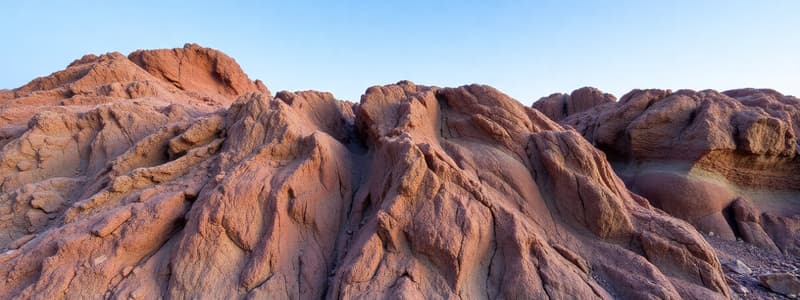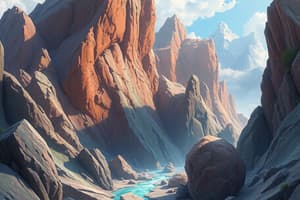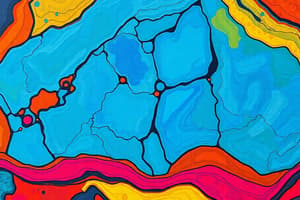Podcast
Questions and Answers
Which of the following is NOT a primary classification of rocks based on their formation?
Which of the following is NOT a primary classification of rocks based on their formation?
- Sedimentary
- Clastic (correct)
- Metamorphic
- Igneous
Igneous rocks are formed from the cooling and solidification of sediments.
Igneous rocks are formed from the cooling and solidification of sediments.
False (B)
What are the two types of metamorphism?
What are the two types of metamorphism?
Contact and Regional
Rocks that undergo change due to intense heat and/or pressure are classified as ________ rocks.
Rocks that undergo change due to intense heat and/or pressure are classified as ________ rocks.
Match the rock type with its formation process:
Match the rock type with its formation process:
Which of the following characteristics is associated with intrusive igneous rocks?
Which of the following characteristics is associated with intrusive igneous rocks?
Clastic sedimentary rocks are formed from minerals dissolved in water and then precipitated out of the solution.
Clastic sedimentary rocks are formed from minerals dissolved in water and then precipitated out of the solution.
Name three examples of igneous rocks.
Name three examples of igneous rocks.
Which type of sedimentary rock forms from the accumulation and lithification of organic debris?
Which type of sedimentary rock forms from the accumulation and lithification of organic debris?
Extrusive igneous rocks are characterized by ________ cooling and ________ crystals.
Extrusive igneous rocks are characterized by ________ cooling and ________ crystals.
Which of the following processes is most directly responsible for the formation of sedimentary rocks?
Which of the following processes is most directly responsible for the formation of sedimentary rocks?
Regional metamorphism is primarily associated with contact zones around igneous intrusions.
Regional metamorphism is primarily associated with contact zones around igneous intrusions.
Describe the difference between clastic and crystalline sedimentary rocks regarding their formation.
Describe the difference between clastic and crystalline sedimentary rocks regarding their formation.
The series of metamorphic rocks formed from shale in order of increasing metamorphism are: shale, ________, ________, schist, and gneiss.
The series of metamorphic rocks formed from shale in order of increasing metamorphism are: shale, ________, ________, schist, and gneiss.
Imagine a rock composed primarily of fossilized coral fragments cemented together. To which major rock class and subgroup would it most likely belong?
Imagine a rock composed primarily of fossilized coral fragments cemented together. To which major rock class and subgroup would it most likely belong?
Flashcards
Rock Classification
Rock Classification
Rocks are classified based on how they are formed.
Igneous Rock Formation
Igneous Rock Formation
Igneous rocks are formed from the cooling and solidification of magma or lava.
Intrusive Igneous Rocks
Intrusive Igneous Rocks
Intrusive igneous rocks cool slowly, leading to large crystals.
Extrusive Igneous Rocks
Extrusive Igneous Rocks
Signup and view all the flashcards
Sedimentary Rock Formation
Sedimentary Rock Formation
Signup and view all the flashcards
Clastic Sedimentary Rocks
Clastic Sedimentary Rocks
Signup and view all the flashcards
Crystalline Sedimentary Rocks
Crystalline Sedimentary Rocks
Signup and view all the flashcards
Organic Sedimentary Rocks
Organic Sedimentary Rocks
Signup and view all the flashcards
Metamorphic Rock Formation
Metamorphic Rock Formation
Signup and view all the flashcards
Contact Metamorphism
Contact Metamorphism
Signup and view all the flashcards
Regional Metamorphism
Regional Metamorphism
Signup and view all the flashcards
Study Notes
- Rocks are classified based on how they are formed.
- The three classifications of rocks are: Igneous, Sedimentary, and Metamorphic.
Igneous Rocks
- Igneous rocks are formed from the cooling and solidification of magma or lava.
- Igneous rocks are classified based on their cooling location and solidification.
- Intrusive rocks cool slowly and have large crystals.
- Extrusive rocks cool quickly and have small or no crystals.
Examples of Igneous Rocks
- Granite
- Pegmatite
- Basalt
- Rhyolite
Sedimentary Rocks
- Sedimentary rocks form from compaction and cementation of sediments.
- Sedimentary rocks are classified according to composition: Clastic, Crystalline, and Organic.
Clastic Sedimentary Rocks
- Clastic sedimentary rocks are composed of fragments, or clasts, of pre-existing minerals and rock.
- Examples of clastic sedimentary rocks are sandstone, breccia, and conglomerate.
Crystalline Sedimentary Rocks
- Crystalline sedimentary rocks, a distinct type of sedimentary rock, originate through a process known as precipitation. This process involves minerals that have become soluble in water, often due to chemical weathering or other geological processes. As the water evaporates or changes in temperature and pressure occur, these dissolved minerals gradually crystallize and solidify, forming a solid rock structure. Common examples of crystalline sedimentary rocks include limestone and rock salt, which hold significant geological and economic importance. Additionally, their formation can provide insights into past environmental conditions and contribute to natural resource deposits.
Organic Sedimentary Rocks
- Organic sedimentary rocks form from the accumulation and lithification of organic debris, such as leaves, roots, and other plant or animal material.
Metamorphic Rocks
- Metamorphic rocks are changed by exposure to intense heat and/or pressure.
- Two types of metamorphism are contact and regional.
Studying That Suits You
Use AI to generate personalized quizzes and flashcards to suit your learning preferences.





